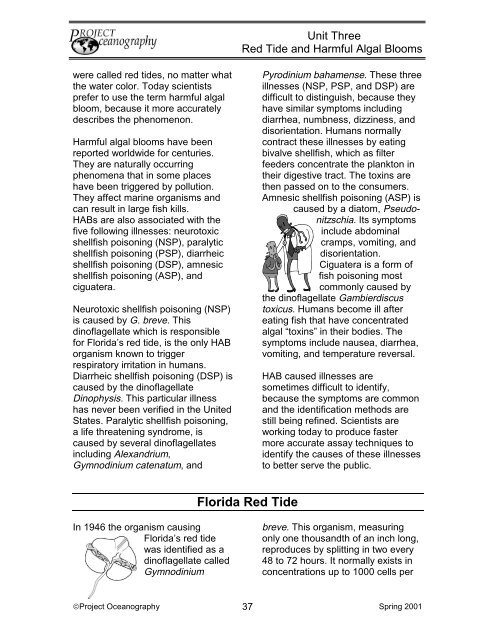Red Tide and Harmful Algal Blooms - College of Marine Science
Red Tide and Harmful Algal Blooms - College of Marine Science
Red Tide and Harmful Algal Blooms - College of Marine Science
Create successful ePaper yourself
Turn your PDF publications into a flip-book with our unique Google optimized e-Paper software.
Unit Three<br />
<strong>Red</strong> <strong>Tide</strong> <strong>and</strong> <strong>Harmful</strong> <strong>Algal</strong> <strong>Blooms</strong><br />
were called red tides, no matter what<br />
the water color. Today scientists<br />
prefer to use the term harmful algal<br />
bloom, because it more accurately<br />
describes the phenomenon.<br />
<strong>Harmful</strong> algal blooms have been<br />
reported worldwide for centuries.<br />
They are naturally occurring<br />
phenomena that in some places<br />
have been triggered by pollution.<br />
They affect marine organisms <strong>and</strong><br />
can result in large fish kills.<br />
HABs are also associated with the<br />
five following illnesses: neurotoxic<br />
shellfish poisoning (NSP), paralytic<br />
shellfish poisoning (PSP), diarrheic<br />
shellfish poisoning (DSP), amnesic<br />
shellfish poisoning (ASP), <strong>and</strong><br />
ciguatera.<br />
Neurotoxic shellfish poisoning (NSP)<br />
is caused by G. breve. This<br />
din<strong>of</strong>lagellate which is responsible<br />
for Florida’s red tide, is the only HAB<br />
organism known to trigger<br />
respiratory irritation in humans.<br />
Diarrheic shellfish poisoning (DSP) is<br />
caused by the din<strong>of</strong>lagellate<br />
Dinophysis. This particular illness<br />
has never been verified in the United<br />
States. Paralytic shellfish poisoning,<br />
a life threatening syndrome, is<br />
caused by several din<strong>of</strong>lagellates<br />
including Alex<strong>and</strong>rium,<br />
Gymnodinium catenatum, <strong>and</strong><br />
Pyrodinium bahamense. These three<br />
illnesses (NSP, PSP, <strong>and</strong> DSP) are<br />
difficult to distinguish, because they<br />
have similar symptoms including<br />
diarrhea, numbness, dizziness, <strong>and</strong><br />
disorientation. Humans normally<br />
contract these illnesses by eating<br />
bivalve shellfish, which as filter<br />
feeders concentrate the plankton in<br />
their digestive tract. The toxins are<br />
then passed on to the consumers.<br />
Amnesic shellfish poisoning (ASP) is<br />
caused by a diatom, Pseudonitzschia.<br />
Its symptoms<br />
include abdominal<br />
cramps, vomiting, <strong>and</strong><br />
disorientation.<br />
Ciguatera is a form <strong>of</strong><br />
fish poisoning most<br />
commonly caused by<br />
the din<strong>of</strong>lagellate Gambierdiscus<br />
toxicus. Humans become ill after<br />
eating fish that have concentrated<br />
algal “toxins” in their bodies. The<br />
symptoms include nausea, diarrhea,<br />
vomiting, <strong>and</strong> temperature reversal.<br />
HAB caused illnesses are<br />
sometimes difficult to identify,<br />
because the symptoms are common<br />
<strong>and</strong> the identification methods are<br />
still being refined. Scientists are<br />
working today to produce faster<br />
more accurate assay techniques to<br />
identify the causes <strong>of</strong> these illnesses<br />
to better serve the public.<br />
Florida <strong>Red</strong> <strong>Tide</strong><br />
In 1946 the organism causing<br />
Florida’s red tide<br />
was identified as a<br />
din<strong>of</strong>lagellate called<br />
Gymnodinium<br />
breve. This organism, measuring<br />
only one thous<strong>and</strong>th <strong>of</strong> an inch long,<br />
reproduces by splitting in two every<br />
48 to 72 hours. It normally exists in<br />
concentrations up to 1000 cells per<br />
©Project Oceanography 37<br />
Spring 2001
















